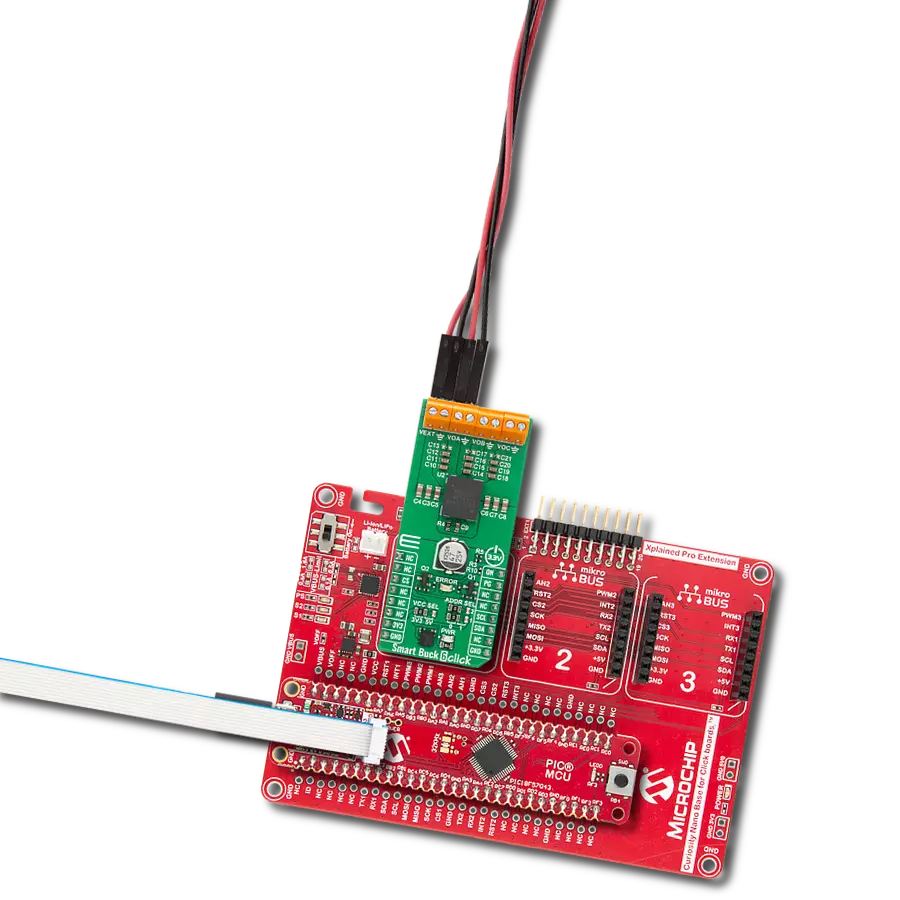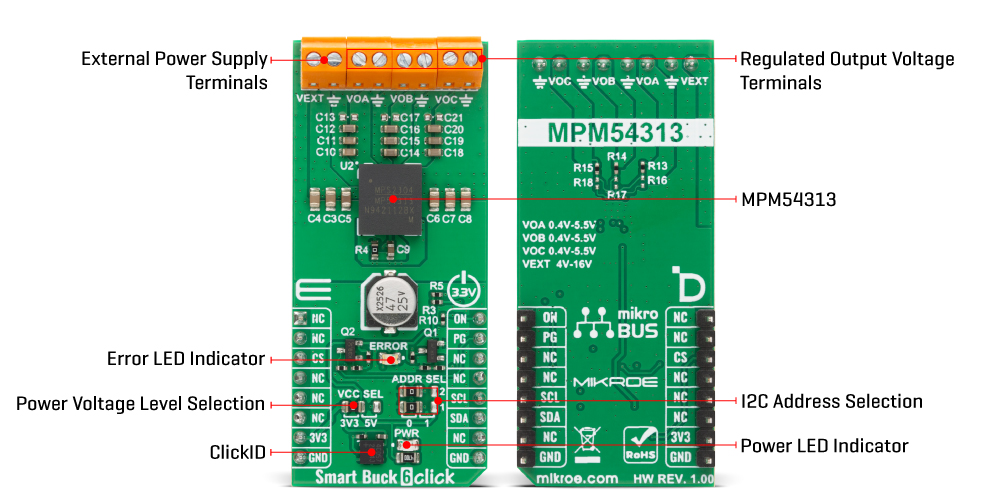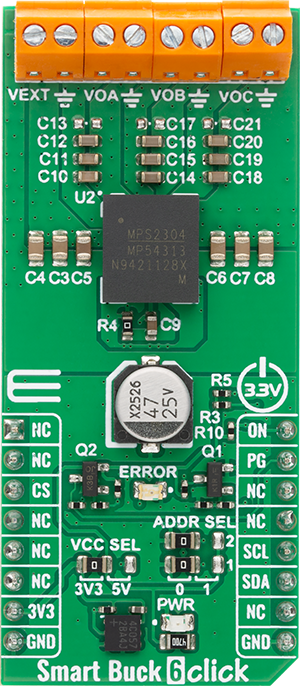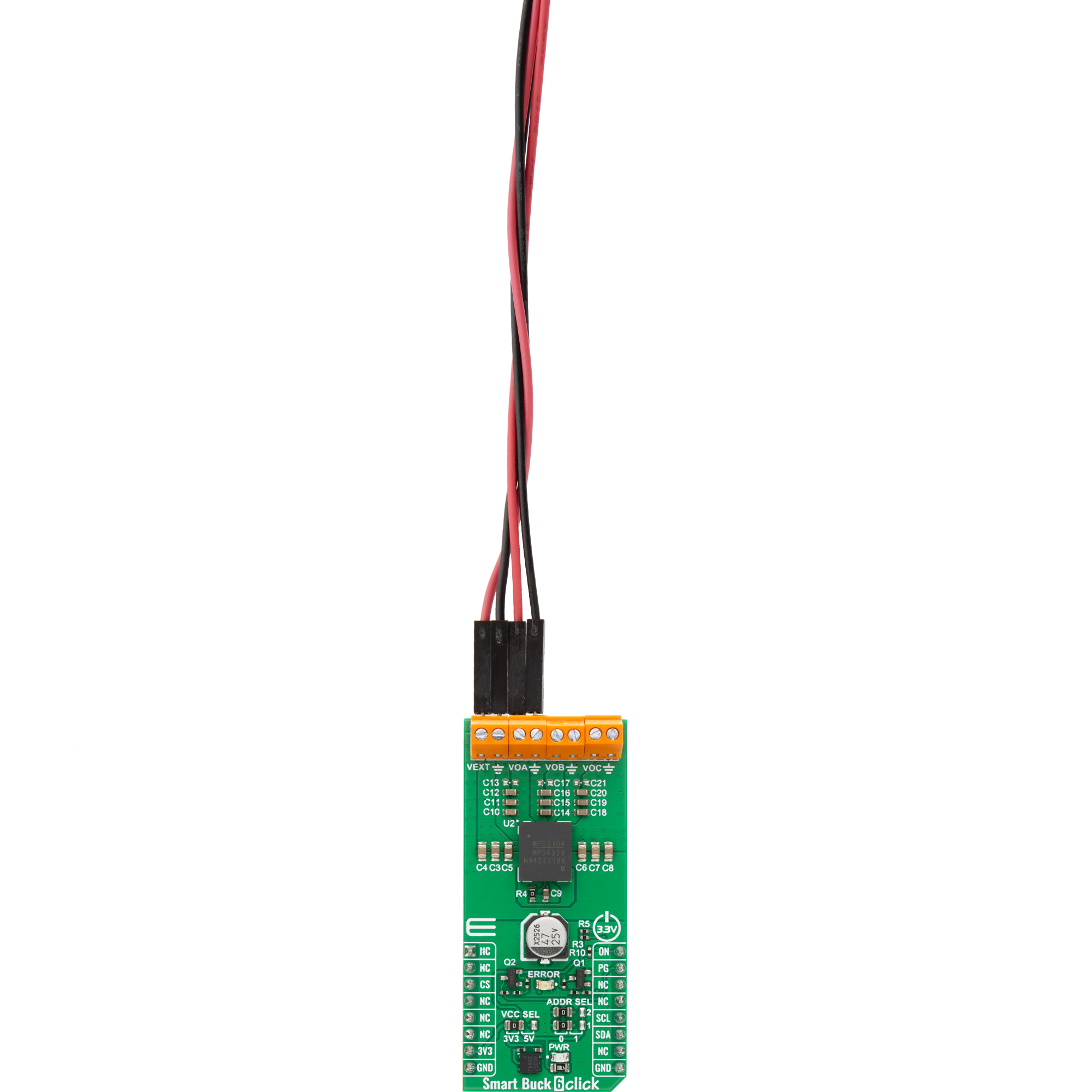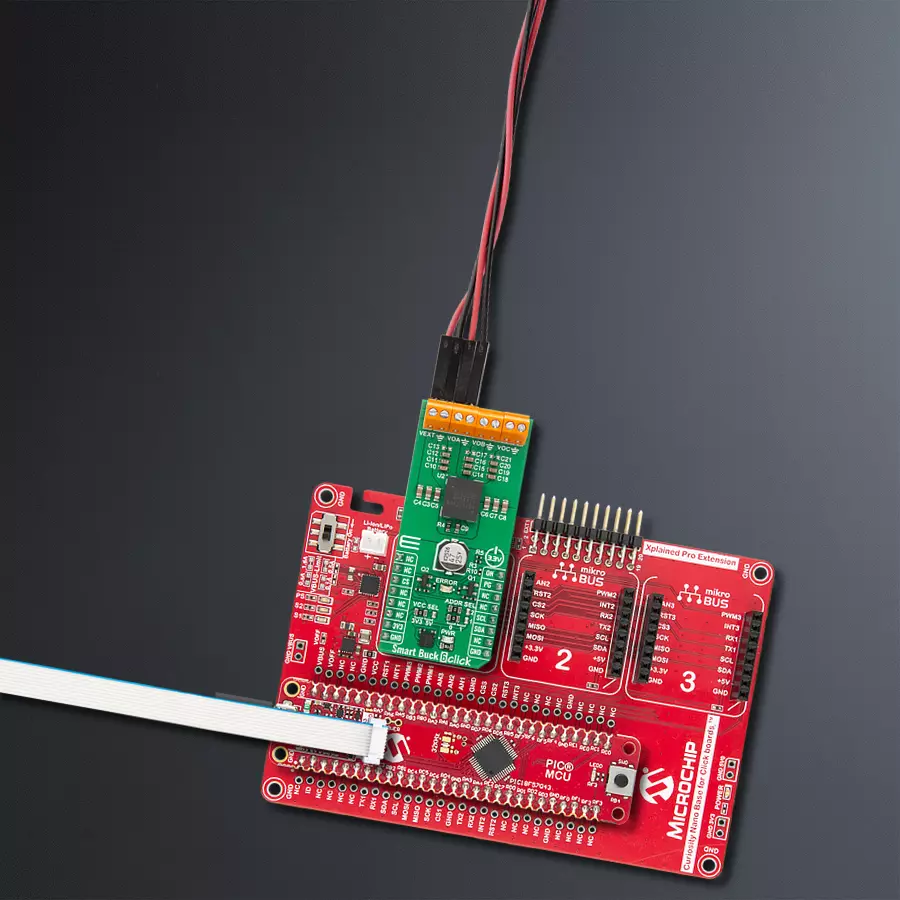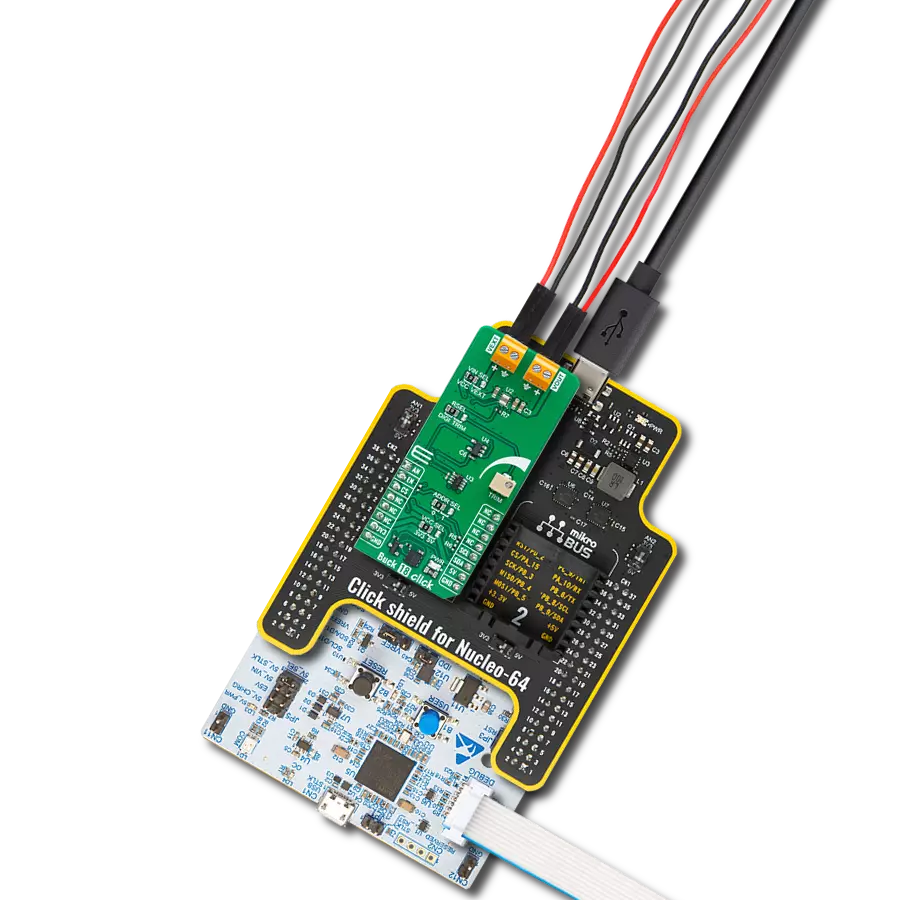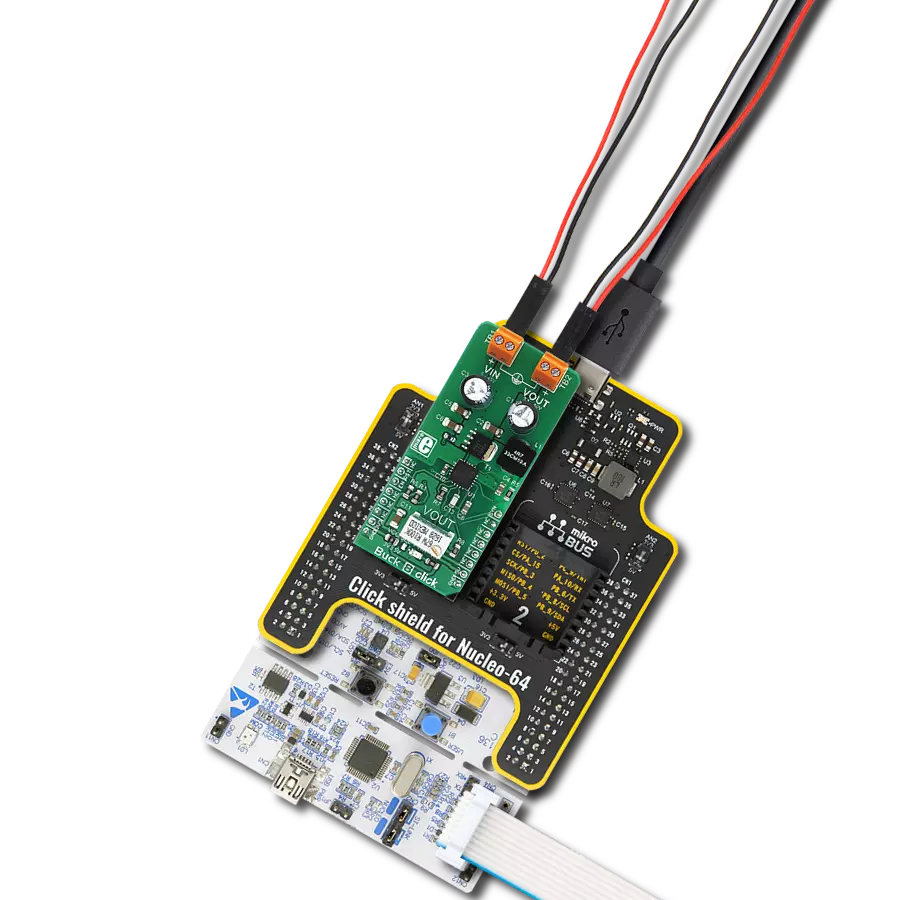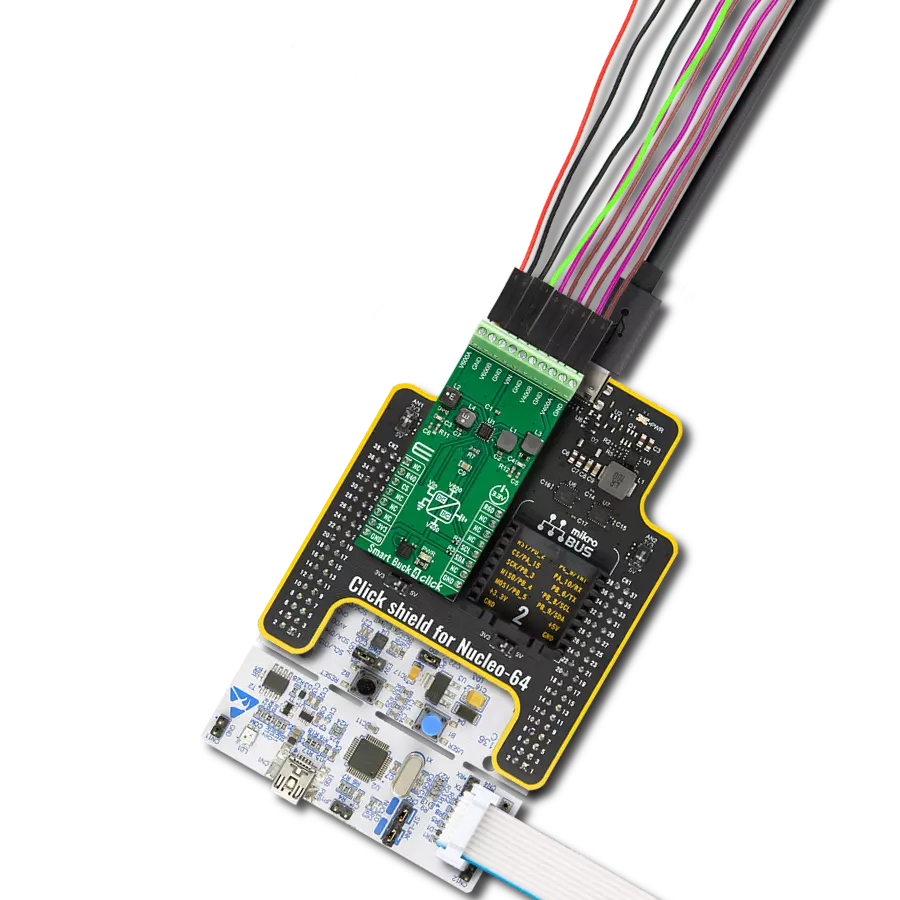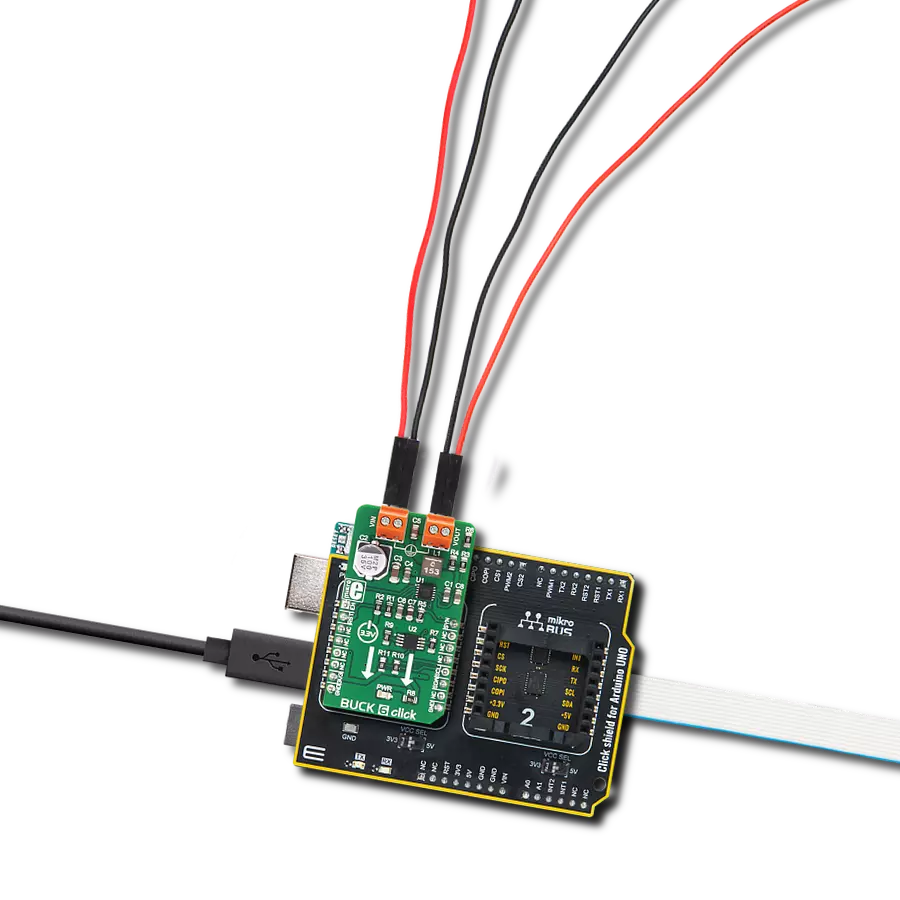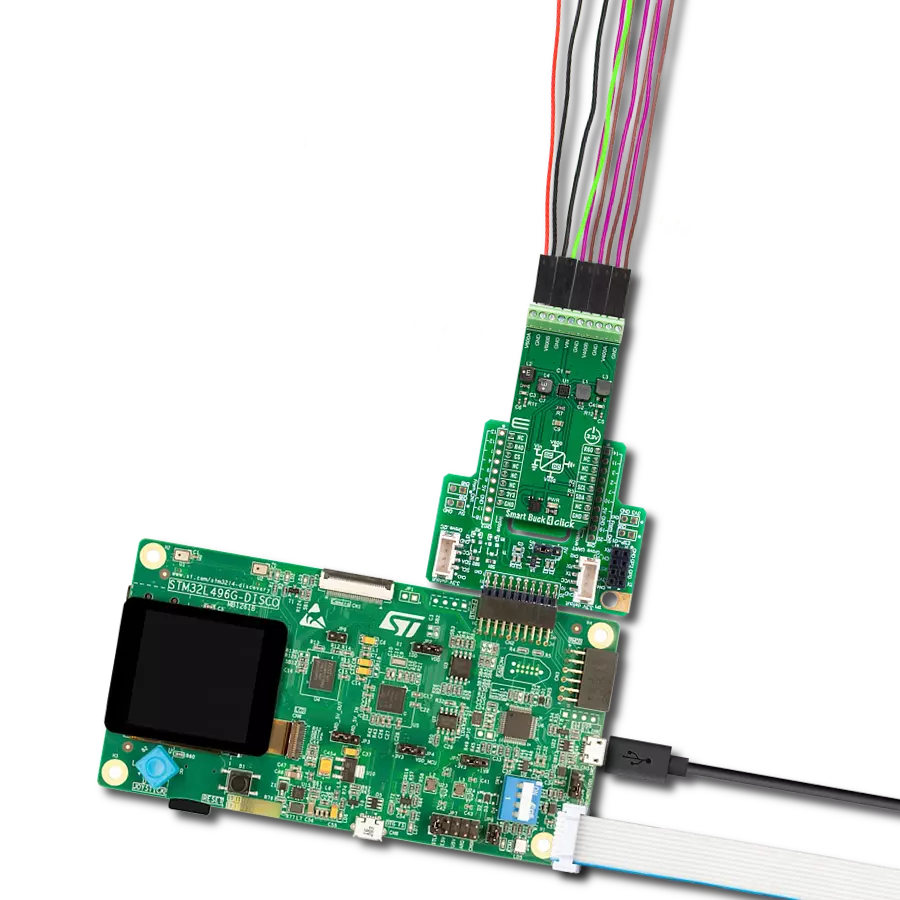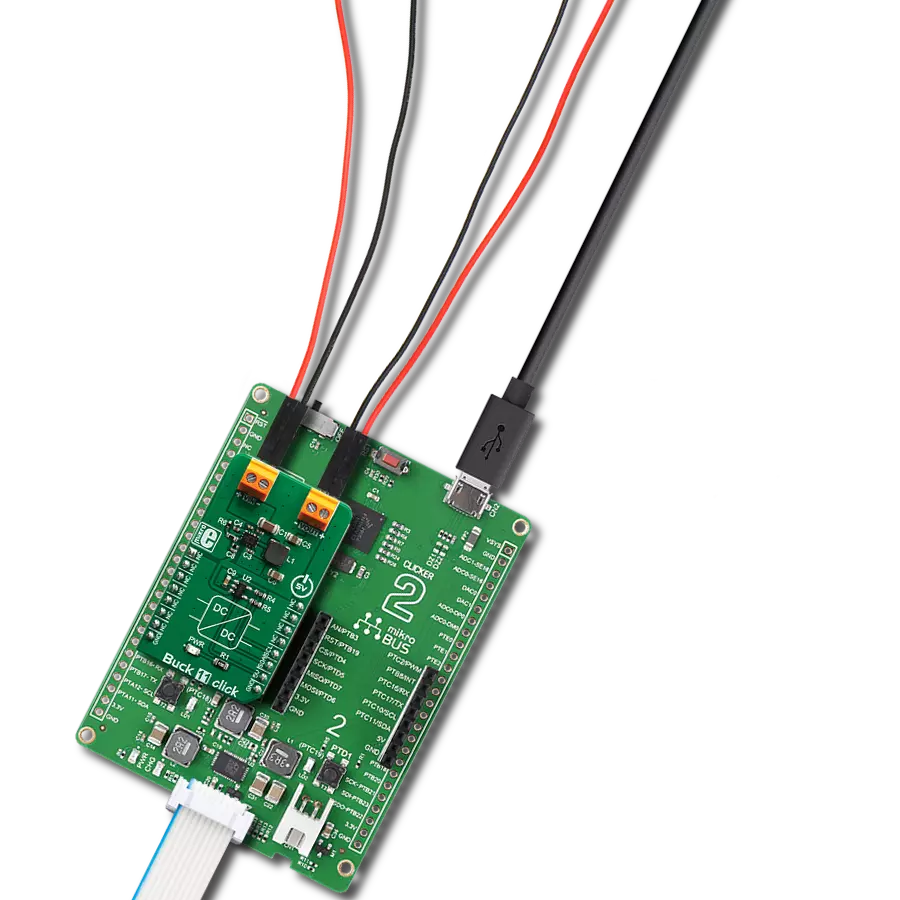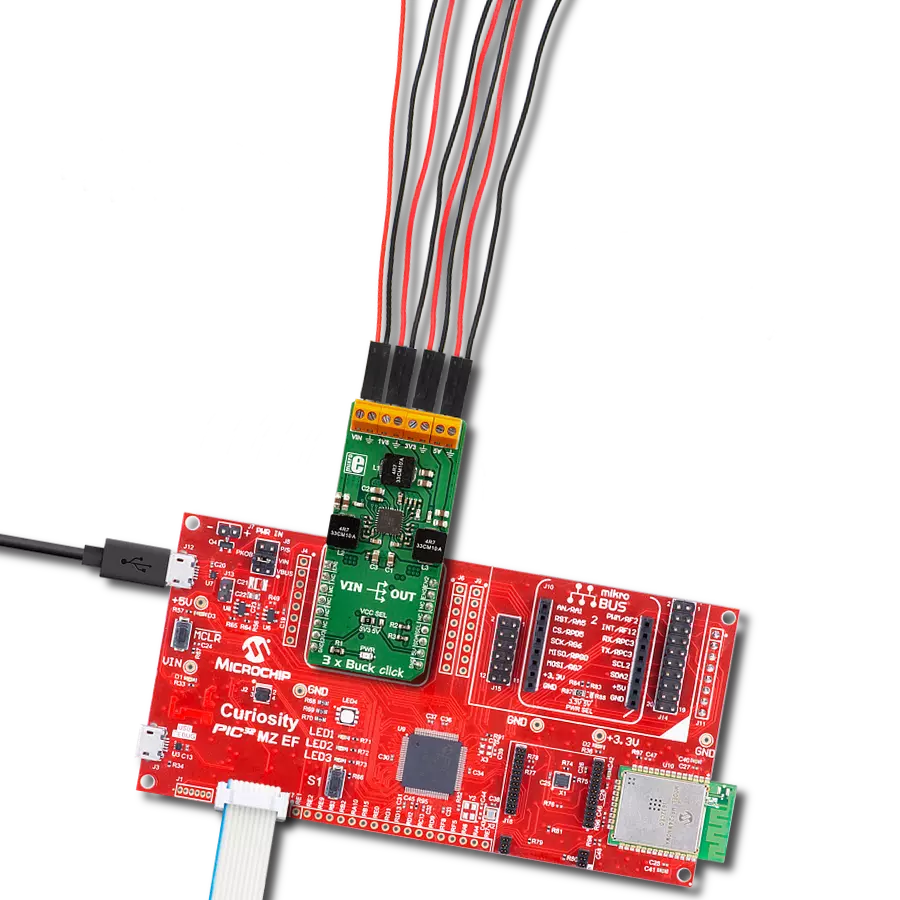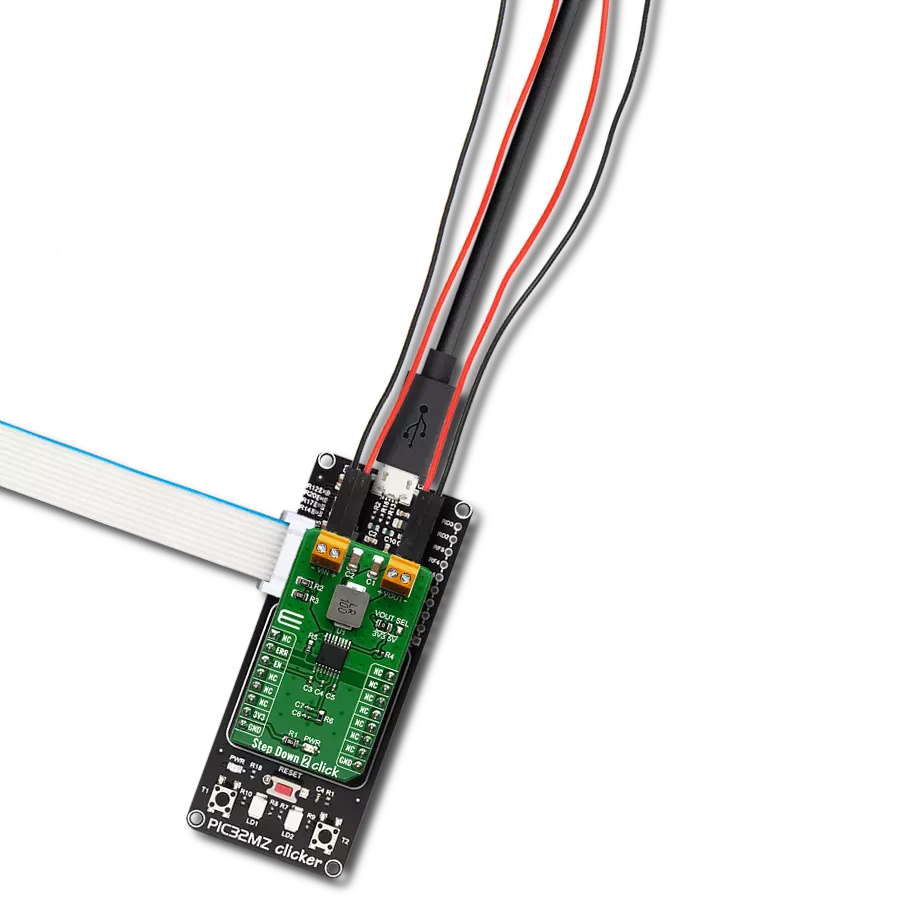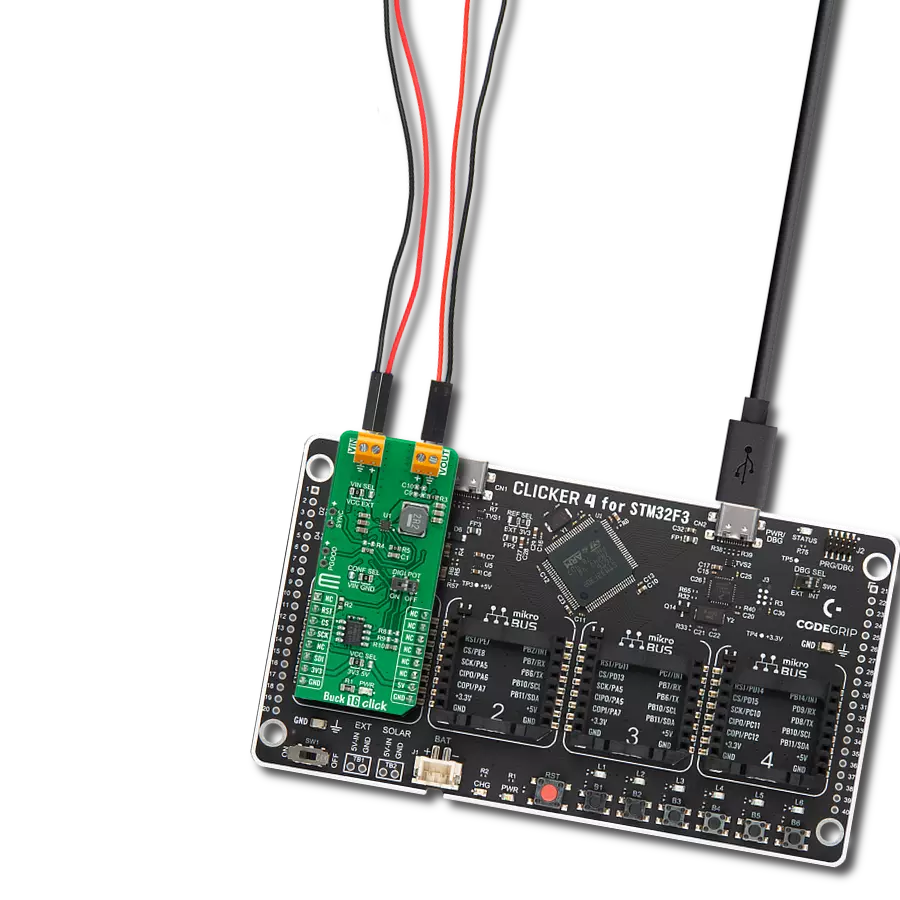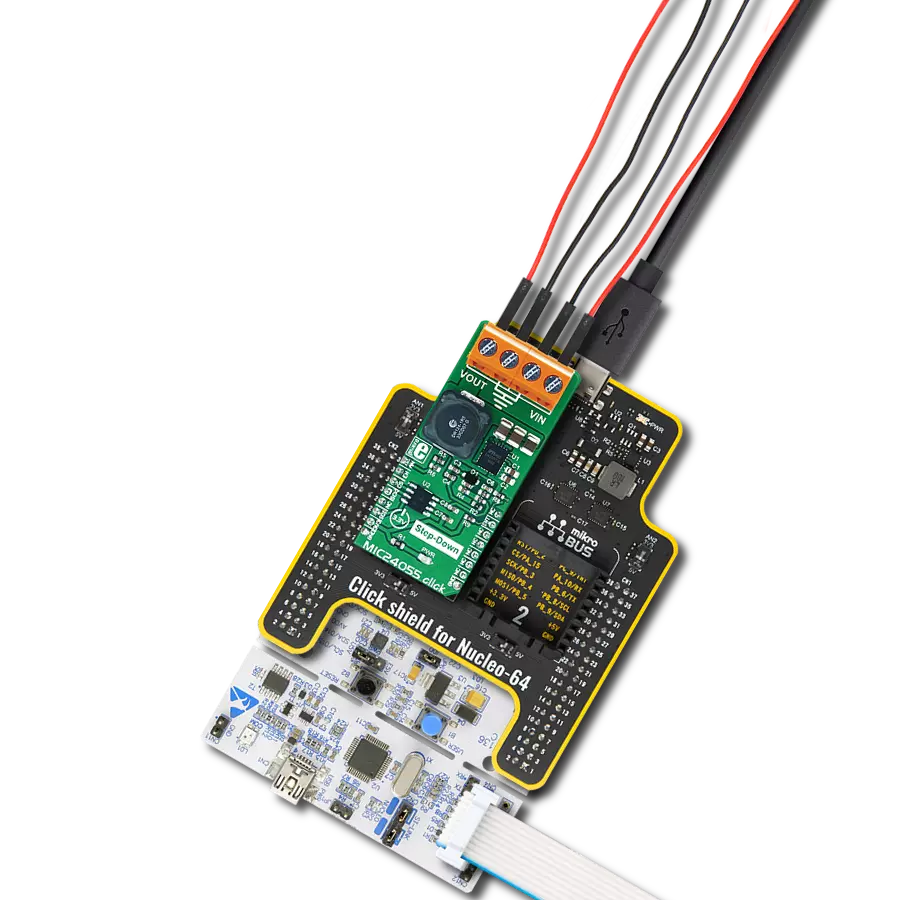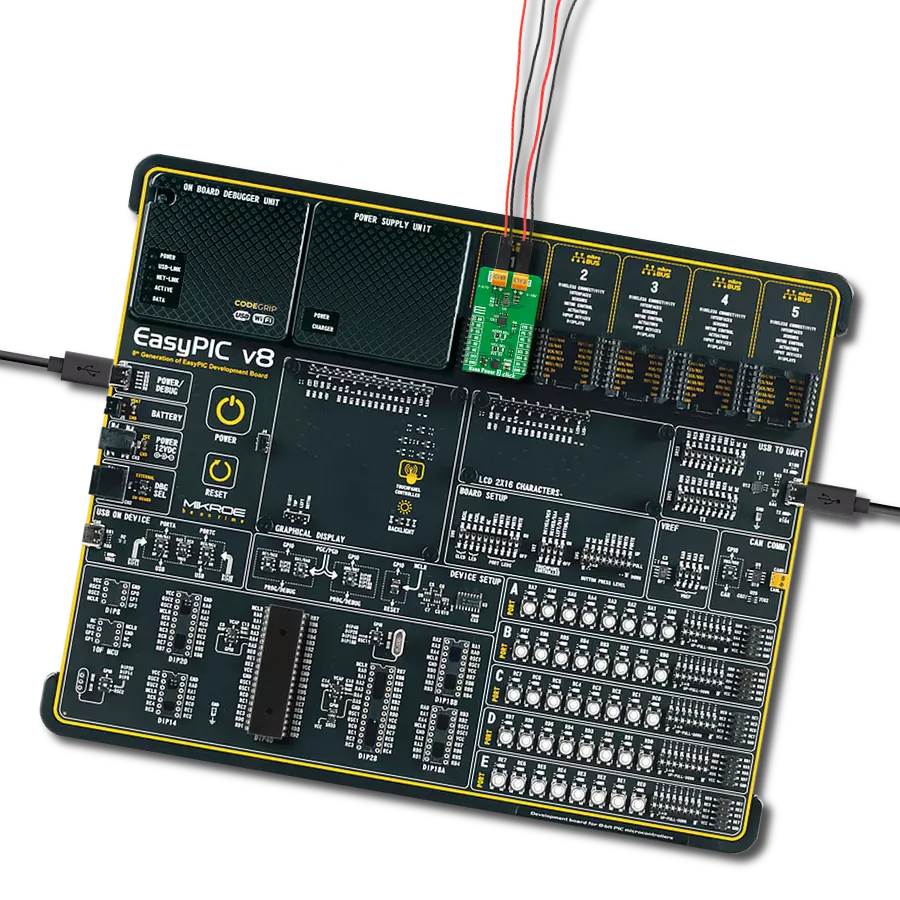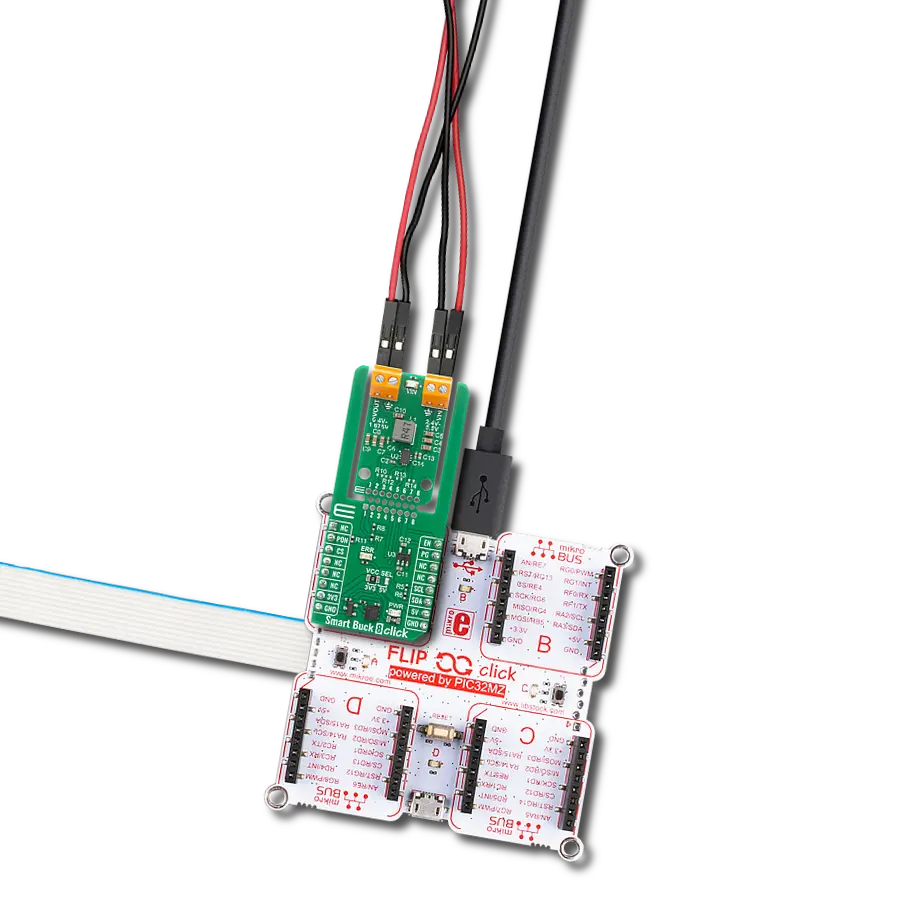Power embedded systems with three independent buck converters that deliver stable and configurable power outputs
A
A
Hardware Overview
How does it work?
Smart Buck 6 Click is based on the MPM54313, a triple 3A power module from MPS that provides a highly integrated power management solution for a wide range of embedded applications. This module offers three independent buck converters, each capable of delivering up to 3A of continuous output current, with flexible configuration through the I2C interface. It supports a wide input voltage range from 4V to 16V at the VEXT terminal, while the output voltages can be adjusted digitally via I2C or set through multiple-time programmable memory in the range of 0.4V to 5.5V on all VOx outputs, ensuring adaptability to different system requirements. The device integrates sophisticated power-on and power-off sequencing, configurable soft-start, compensation, and comprehensive protection features including under-voltage lockout, over-voltage, under-voltage, over-current protection, and thermal shutdown, ensuring safe and reliable operation. Its constant-on-time control
architecture enables ultra-fast transient response, making it ideal for powering sensitive digital systems such as FPGAs, ASICs, and optical communication modules. For higher current demands, Buck channels A and B can operate in parallel in interleaving mode, supporting up to 6A with active current balancing, while configurable active voltage positioning allows up to three outputs to be paralleled with passive current sharing. This level of integration and flexibility makes Smart Buck 6 Click an excellent choice for networking, telecommunications, and other complex embedded systems requiring compact and programmable multi-rail power supplies. The MPM54313 interfaces with the host MCU via an I2C-compatible serial interface operating at standard (100kHz) or fast mode (400kHz) clock speeds, enabling control and monitoring of output voltages and status registers. The I2C address of the MPM54313 can be easily configured via onboard jumpers marked
ADDR SEL, allowing multiple devices to coexist on the same bus. A dedicated ON pin allows for external enable/disable control of the entire power module, supporting power domain management in software-controlled power sequencing scenarios. Additionally, the MPM54313 features a Power Good (PG pin) output that is also routed to an onboard red LED labeled ERROR, which provides real-time visual indication of any voltage irregularities or faults - indicate valid and stable output voltages. This Click board™ can operate with either 3.3V or 5V logic voltage levels selected via the VCC SEL jumper. This way, both 3.3V and 5V capable MCUs can use the communication lines properly. Also, this Click board™ comes equipped with a library containing easy-to-use functions and an example code that can be used as a reference for further development.
Features overview
Development board
PIC18F57Q43 Curiosity Nano evaluation kit is a cutting-edge hardware platform designed to evaluate microcontrollers within the PIC18-Q43 family. Central to its design is the inclusion of the powerful PIC18F57Q43 microcontroller (MCU), offering advanced functionalities and robust performance. Key features of this evaluation kit include a yellow user LED and a responsive
mechanical user switch, providing seamless interaction and testing. The provision for a 32.768kHz crystal footprint ensures precision timing capabilities. With an onboard debugger boasting a green power and status LED, programming and debugging become intuitive and efficient. Further enhancing its utility is the Virtual serial port (CDC) and a debug GPIO channel (DGI
GPIO), offering extensive connectivity options. Powered via USB, this kit boasts an adjustable target voltage feature facilitated by the MIC5353 LDO regulator, ensuring stable operation with an output voltage ranging from 1.8V to 5.1V, with a maximum output current of 500mA, subject to ambient temperature and voltage constraints.
Microcontroller Overview
MCU Card / MCU

Architecture
PIC
MCU Memory (KB)
128
Silicon Vendor
Microchip
Pin count
48
RAM (Bytes)
8196
You complete me!
Accessories
Curiosity Nano Base for Click boards is a versatile hardware extension platform created to streamline the integration between Curiosity Nano kits and extension boards, tailored explicitly for the mikroBUS™-standardized Click boards and Xplained Pro extension boards. This innovative base board (shield) offers seamless connectivity and expansion possibilities, simplifying experimentation and development. Key features include USB power compatibility from the Curiosity Nano kit, alongside an alternative external power input option for enhanced flexibility. The onboard Li-Ion/LiPo charger and management circuit ensure smooth operation for battery-powered applications, simplifying usage and management. Moreover, the base incorporates a fixed 3.3V PSU dedicated to target and mikroBUS™ power rails, alongside a fixed 5.0V boost converter catering to 5V power rails of mikroBUS™ sockets, providing stable power delivery for various connected devices.
Used MCU Pins
mikroBUS™ mapper
Take a closer look
Click board™ Schematic
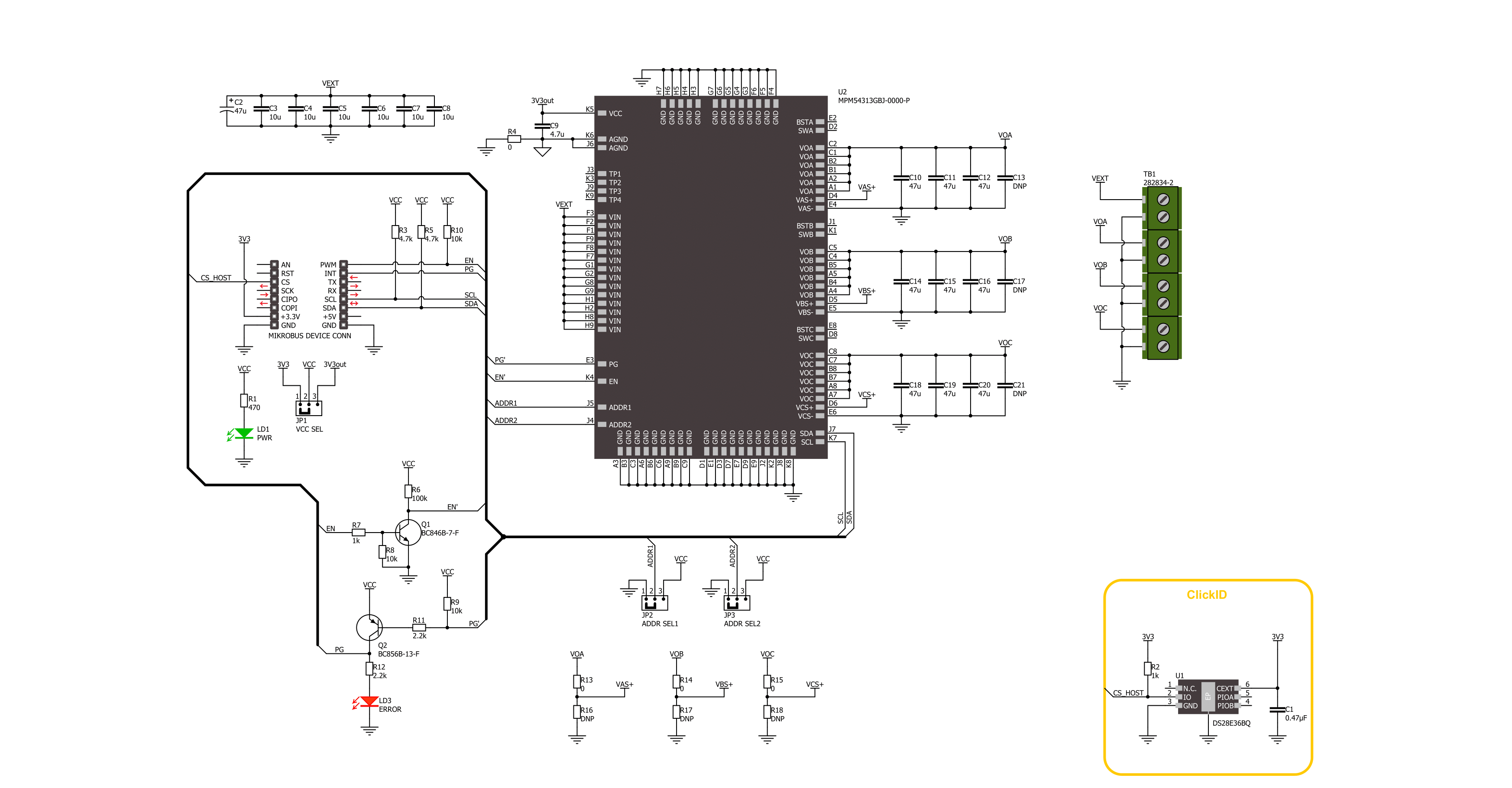
Step by step
Project assembly
Software Support
Library Description
Smart Buck 6 Click demo application is developed using the NECTO Studio, ensuring compatibility with mikroSDK's open-source libraries and tools. Designed for plug-and-play implementation and testing, the demo is fully compatible with all development, starter, and mikromedia boards featuring a mikroBUS™ socket.
Example Description
This example demonstrates the use of the Smart Buck 6 Click board. The application changes the output voltage of all three buck converters (A, B, and C) in a periodic manner and logs the output current of each. It also monitors the PG (Power Good) pin to detect and log any fault conditions such as over-temperature, overvoltage, undervoltage, or overcurrent.
Key functions:
smartbuck6_cfg_setup- This function initializes Click configuration structure to initial values.smartbuck6_init- This function initializes all necessary pins and peripherals used for this Click board.smartbuck6_default_cfg- This function executes a default configuration of Smart Buck 6 Click board.smartbuck6_set_buck_vout- This function sets the output voltage for one or more buck regulators.smartbuck6_read_buck_current- This function reads and returns the output current of the selected buck regulator.smartbuck6_get_pg_pin- This function reads the logic level of the PG pin.
Application Init
Initializes the logger and the Smart Buck 6 Click driver and applies the default configuration.
Application Task
Periodically increases or decreases the output voltage, reads and logs the output current for each buck channel, and checks for any fault conditions indicated via the PG pin and status registers.
Open Source
Code example
The complete application code and a ready-to-use project are available through the NECTO Studio Package Manager for direct installation in the NECTO Studio. The application code can also be found on the MIKROE GitHub account.
/*!
* @file main.c
* @brief Smart Buck 6 Click example
*
* # Description
* This example demonstrates the use of the Smart Buck 6 Click board. The application changes
* the output voltage of all three buck converters (A, B, and C) in a periodic manner and logs
* the output current of each. It also monitors the PG (Power Good) pin to detect and log any
* fault conditions such as over-temperature, overvoltage, undervoltage, or overcurrent.
*
* The demo application is composed of two sections :
*
* ## Application Init
* Initializes the logger and the Smart Buck 6 Click driver and applies the default configuration.
*
* ## Application Task
* Periodically increases or decreases the output voltage, reads and logs the output current for
* each buck channel, and checks for any fault conditions indicated via the PG pin and status registers.
*
* @note
* Ensure that a valid power supply and appropriate load are connected to the Click board
* to observe proper current and fault condition readings.
*
* @author Stefan Filipovic
*
*/
#include "board.h"
#include "log.h"
#include "smartbuck6.h"
static smartbuck6_t smartbuck6;
static log_t logger;
/**
* @brief Smart Buck 6 display status function.
* @details This function parses and logs all detected status flags from the Smart Buck 6 Click board
* including over-temperature, power-good, overvoltage, undervoltage, and overcurrent conditions.
* @param[in] status : Status register structure.
* See #smartbuck6_status_t object definition for detailed explanation.
* @return None.
* @note This function outputs human-readable messages via the logger for each active status flag.
*/
static void smartbuck6_display_status ( smartbuck6_status_t status );
void application_init ( void )
{
log_cfg_t log_cfg; /**< Logger config object. */
smartbuck6_cfg_t smartbuck6_cfg; /**< Click config object. */
/**
* Logger initialization.
* Default baud rate: 115200
* Default log level: LOG_LEVEL_DEBUG
* @note If USB_UART_RX and USB_UART_TX
* are defined as HAL_PIN_NC, you will
* need to define them manually for log to work.
* See @b LOG_MAP_USB_UART macro definition for detailed explanation.
*/
LOG_MAP_USB_UART( log_cfg );
log_init( &logger, &log_cfg );
log_info( &logger, " Application Init " );
// Click initialization.
smartbuck6_cfg_setup( &smartbuck6_cfg );
SMARTBUCK6_MAP_MIKROBUS( smartbuck6_cfg, MIKROBUS_1 );
if ( I2C_MASTER_ERROR == smartbuck6_init( &smartbuck6, &smartbuck6_cfg ) )
{
log_error( &logger, " Communication init." );
for ( ; ; );
}
if ( SMARTBUCK6_ERROR == smartbuck6_default_cfg ( &smartbuck6 ) )
{
log_error( &logger, " Default configuration." );
for ( ; ; );
}
log_info( &logger, " Application Task " );
}
void application_task ( void )
{
smartbuck6_status_t status;
static uint16_t vout = SMARTBUCK6_VOUT_MV_MIN;
static int16_t vout_step = 200;
uint16_t current = 0;
if ( smartbuck6_get_pg_pin ( &smartbuck6 ) )
{
log_printf( &logger, "\r\n Fault indication detected via PG pin!\r\n" );
if ( SMARTBUCK6_OK == smartbuck6_read_status ( &smartbuck6, &status ) )
{
smartbuck6_display_status ( status );
}
smartbuck6_clear_status( &smartbuck6 );
}
if ( SMARTBUCK6_OK == smartbuck6_set_buck_vout ( &smartbuck6, SMARTBUCK6_BUCK_ALL, vout ) )
{
log_printf ( &logger, "\r\n All outputs voltage: %u mV\r\n", vout );
vout += vout_step;
if ( ( vout > SMARTBUCK6_VOUT_MV_MAX ) || ( vout < SMARTBUCK6_VOUT_MV_MIN ) )
{
vout_step = -vout_step;
vout += vout_step;
vout += vout_step;
}
Delay_ms ( 100 );
if ( SMARTBUCK6_OK == smartbuck6_read_buck_current ( &smartbuck6, SMARTBUCK6_BUCK_A, ¤t ) )
{
log_printf ( &logger, " Buck A current: %u mA\r\n", current );
}
if ( SMARTBUCK6_OK == smartbuck6_read_buck_current ( &smartbuck6, SMARTBUCK6_BUCK_B, ¤t ) )
{
log_printf ( &logger, " Buck B current: %u mA\r\n", current );
}
if ( SMARTBUCK6_OK == smartbuck6_read_buck_current ( &smartbuck6, SMARTBUCK6_BUCK_C, ¤t ) )
{
log_printf ( &logger, " Buck C current: %u mA\r\n", current );
}
}
Delay_ms ( 1000 );
Delay_ms ( 1000 );
}
int main ( void )
{
/* Do not remove this line or clock might not be set correctly. */
#ifdef PREINIT_SUPPORTED
preinit();
#endif
application_init( );
for ( ; ; )
{
application_task( );
}
return 0;
}
static void smartbuck6_display_status ( smartbuck6_status_t status )
{
if ( status.status_0 )
{
if ( status.status_0 & SMARTBUCK6_STATUS_0_OVER_TEMP_STATUS )
{
log_printf ( &logger, " A critical temperature shutdown has occurred\r\n" );
}
if ( status.status_0 & SMARTBUCK6_STATUS_0_BUCK_A_PWR_NOT_GOOD )
{
log_printf ( &logger, " Buck A output power is not good\r\n" );
}
if ( status.status_0 & SMARTBUCK6_STATUS_0_BUCK_B_PWR_NOT_GOOD )
{
log_printf ( &logger, " Buck B output power is not good\r\n" );
}
if ( status.status_0 & SMARTBUCK6_STATUS_0_BUCK_C_PWR_NOT_GOOD )
{
log_printf ( &logger, " Buck C output power is not good\r\n" );
}
if ( status.status_0 & SMARTBUCK6_STATUS_0_VIN_OV )
{
log_printf ( &logger, " A VIN OV condition has occurred\r\n" );
}
}
if ( status.status_1 )
{
if ( status.status_1 & SMARTBUCK6_STATUS_1_BUCK_A_OV )
{
log_printf ( &logger, " A buck A output OV condition has occurred\r\n" );
}
if ( status.status_1 & SMARTBUCK6_STATUS_1_BUCK_B_OV )
{
log_printf ( &logger, " A buck B output OV condition has occurred\r\n" );
}
if ( status.status_1 & SMARTBUCK6_STATUS_1_BUCK_C_OV )
{
log_printf ( &logger, " A buck C output OV condition has occurred\r\n" );
}
if ( status.status_1 & SMARTBUCK6_STATUS_1_BUCK_A_UV )
{
log_printf ( &logger, " A buck A output UV condition has occurred\r\n" );
}
if ( status.status_1 & SMARTBUCK6_STATUS_1_BUCK_B_UV )
{
log_printf ( &logger, " A buck B output UV condition has occurred\r\n" );
}
if ( status.status_1 & SMARTBUCK6_STATUS_1_BUCK_C_UV )
{
log_printf ( &logger, " A buck C output UV condition has occurred\r\n" );
}
}
if ( status.oc_status )
{
if ( status.oc_status & SMARTBUCK6_OC_STATUS_BUCK_A_OC )
{
log_printf ( &logger, " There is an output OC condition on buck A\r\n" );
}
if ( status.oc_status & SMARTBUCK6_OC_STATUS_BUCK_B_OC )
{
log_printf ( &logger, " There is an output OC condition on buck B\r\n" );
}
if ( status.oc_status & SMARTBUCK6_OC_STATUS_BUCK_C_OC )
{
log_printf ( &logger, " There is an output OC condition on buck C\r\n" );
}
}
}
// ------------------------------------------------------------------------ END
Additional Support
Resources
Category:Buck
